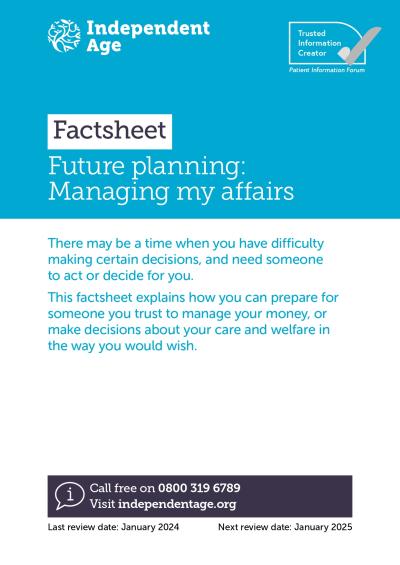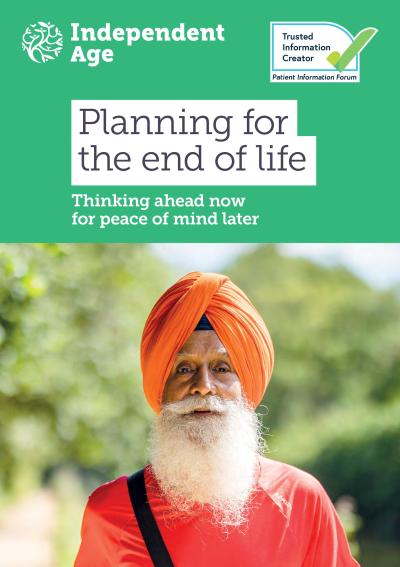Related publications

Future planning: Managing my affairs

There may come a time when you’re unable to make decisions or express your wishes about how you would like to be cared for and what medical treatment you would want. Advance decisions and advance statements let you record your wishes in writing to help make sure they are respected if this situation arises.
The ability to make, understand and communicate decisions when they need to be made. You might lose capacity for a number of reasons: for example, because of an illness such as dementia, or if you were unconscious. Our factsheet Future planning: Mental capacity has more information on the rules around this.
An advance statement records how you would like to be looked after you lose mental capacity. It should be considered by anyone who is involved in your care, but it is not legally binding.
An advance statement might include information about:
You don’t have to use a specific form or template for your advance statement, but Compassion in Dying has a template form you could use. You don’t need to sign it, but it’s sensible to sign and date it to help people confirm that it represents your wishes.
It’s a good idea to give a copy of your advance statement to your GP and your medical team so it can be kept with your medical notes. You might also want to discuss it with family or friends, and if someone holds lasting power of attorney for you, make sure they have a copy. It must be taken into account if someone is deciding what’s in your best interests.
An advance decision/directive is a way to specify treatments or care that you would want to refuse in certain circumstances, if you don’t have mental capacity at that time. They are formally called Advanced Decisions to Refuse Treatment, so you may have come across this term. In England and Wales, they are also called advanced decisions, and advanced directives in Scotland.
In England and Wales, they are legally binding, but need to meet certain criteria. Once an advance decision has been made, doctors and healthcare professionals must follow it.
In Scotland, advance directives are not legally binding themselves, but if someone is making a decision for you, they have to take into account what you have written in an advance directive. They are still widely recognised and used by healthcare professionals.
You can use an advance decision/directive to refuse any treatment, including life-sustaining treatment such as:
It can’t be used to:
An advance decision/directive can only be used if you lose the mental capacity to make or communicate your decisions.
There is no official form for writing an advance decision/directive and it doesn’t have to be in writing, unless you want to refuse potentially life-sustaining treatment. Compassion in Dying has an online service you could use, or you can download or ask for a paper form. You can have both an advance statement and an advance decision/directive.
It’s important to tell people that you have made an advance decision/directive and it’s a good idea to discuss your wishes with a GP or healthcare professional. They can make sure you understand the implications of your decision and they can put it in your medical notes. Your GP or healthcare professional could also confirm that you have the mental capacity to make an advance decision/directive.
You should regularly review and update an advance decision/directive to make sure it reflects your changing health needs. You can change an advance decision/directive later if you want to, but make sure you record those changes and let people (including your GP) know about them. It is important to inform people you trust, as your wishes might not be followed if people are unaware of your advance decisions/directives.
If you want to refuse life-sustaining treatment, your advance decision/directive must:
You may want to discuss your decision with family or friends, but the final decision is up to you.
If you wish to withdraw your advance decision/directive, you can do so at any time, both verbally and in writing, as long as you have mental capacity. You should then ensure the original written document is destroyed and that everyone who knew about it knows it has been cancelled. Healthcare professionals should make a note of this in your records.
If you don’t want to make an advance decision/directive, you might want to give someone else the authority to make decisions about life-sustaining treatment for you by setting up a lasting power of attorney (LPA) for health and welfare. If you have an advance decision/directive and an LPA for health and welfare, the most recent one takes precedence over the other if a decision about your health or care needs to be made.
Advanced statements and advanced decisions/directives both help you stay in control of how you are looked after, if you lose capacity. The difference between them is that advanced statements can include general information about your day-to-day care, and advanced decisions/directives are used to refuse specific medical treatments. This means that, if you don’t have an advanced decision/directive, an advanced statement can still be used to help people make decisions about your medical treatment that are in your best interests.
If you are worried about how you may be cared for if you lose capacity, it is a good idea to make both an advanced decision/directive, and an advanced statement. It is a good idea to communicate as much information about how you would like to be looked after as possible.
Read our guide Planning for the end of life for more information about communicating your wishes for your health and care.


